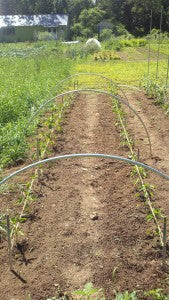Rarely does a northern garden season seem too long, let alone long enough. A gardener’s summer-weary bones may welcome the relief of the first fall frost, but that’s nothing compared to the restlessness of those same bones in early spring when the sun is bright, but not yet hot enough to warm up the garden. For this trying time, dear gardeners, we are grateful for season extension aids. Last week, Doug wrote about how to build a simple cold frame, this week, let’s talk about row covers:
Row covers are plant blankets: woven plastic fabric that protects delicate crops from cold nights and hungry insects. They can either be made to “float” over beds, by being loosely draped directly over plants and sealed to the ground with weights (like rocks or bags of rocks), or they can be held up with low half-moon hoops or A-frame (metal, wood, or PVC pipe) structures, attached to the ground via short stakes (such as re-bar). Row covers are more portable and flexible than cold-frames and cheaper and easier to install than high tunnels. Row cover fabric varies in thickness: the lightest cover lets in the most light, air, and water; it provides the best insect protection and the worst frost protection. The heaviest covers have opposite qualities: less light is able to get through, which slows a plant down a little, but is best for frost protection. At the Seed Library, we find many uses for row covers throughout the growing season, but they are particularly important in those unstable early spring days.
1. Hardening Off. There comes a time when the seedlings you’ve nourished in a cozy house or warm greenhouse have to be sent out into the world, an unpredictable world that is sometimes suddenly overtaken by cold or a powerful wind. Young plants, understandably, are shocked going from full comfort to full exposure to the elements. They need to be eased in: once you transplant the younglings into the ground, cover them with garden fabric. If the cover is thin and lets in plenty of light, it can be left on all day and night until the risk of bad weather passes and the plant is established. If it’s thicker (for colder times), uncover the plants in the warmest part of the day to let them soak in more sun. A thin cover can also be doubled up for extra protection. When plants are small, a floating cover works well – be sure to leave plenty of slack in the fabric so the seedlings can push it up as they grow. For taller, older plants (such as tomatoes, peppers, eggplants later in the season), support hoops, or a similar structure, work better – pull the fabric tight over the hoops to secure it from getting blown off.
Fruiting vegetables should be uncovered when they start to flower to let in pollinators. Plants such as beans, squash, cucumbers, and watermelons are among crops that need pollination to produce a harvest. If it's still too chilly to put covers away when these veggies start to flower, uncover them from morning to midday when many pollinating insects are hard at work.
2. Season Extension. Since row covers trap heat and help keep soil evenly moist, they are not only great for protecting transplants, but for getting a jump start on spring harvests. Keeping direct sowings of hardy veggies under cover will create a pleasing micro-climate for them and speed growth.
Lettuce, arugula, Asian greens, spinach, radish, carrots, broccoli, cabbage, and cauliflower all benefit from this system. Unfortunately, the seeds you sow won’t be the only ones enjoying the micro-climate: weed pressure is stronger under row covers, so stay on top of weeding, especially when your plants are just starting out.
As weather warms, make sure the plants under cover are not overheating. Cool weather-loving plants like spinach or broccoli will let you know if they are too hot with wilting leaves or falling blossoms. If this occurs - uncover them.
3. Pest Protection. Row covers with edges thoroughly sealed to the ground create a protected environment, which many pests cannot infiltrate. Aphids, potato beetles, Japanese beetles, grasshoppers, leaf miners, cabbage worms, root maggots, and vine borers are among the bugs deterred by covers. Row covers also make for good barriers against big garden nuisances such as groundhogs, rabbits, birds, and deer. Unfortunately, they are not foolproof: if insects lay eggs before the fabric is put down, or if they emerge from the soil after winter, row covers won’t help. If an infestation occurs, pick as many bugs off as you can, then replace the covers to keep future insects out. A continuous furrow of soil along the edges of the cover is great for sealing out insects.
 Row Cover Care: Properly maintained, row covers can be reused for three or more seasons. Air dry them to prevent mold before storing away. Store in a sealed container, or suspended - mice find garden fabric a perfect material for their winter home. Small tears can be repaired with a paper stapler or sewn with thread.
Row Cover Care: Properly maintained, row covers can be reused for three or more seasons. Air dry them to prevent mold before storing away. Store in a sealed container, or suspended - mice find garden fabric a perfect material for their winter home. Small tears can be repaired with a paper stapler or sewn with thread.








